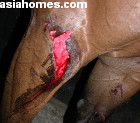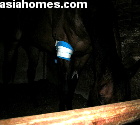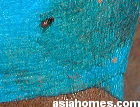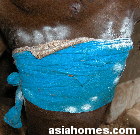|
Toa Payoh
Vets Clinical Research
Making veterinary surgery alive
to a veterinary student studying in Australia
using real case studies and pictures |
The horse kicked the vet
Part 2
Dr
Sing Kong Yuen, BVMS (Glasgow), MRCVS
First written: 06 May, 2010
Date:
07 May, 2010 |
 toapayohvets.com toapayohvets.com
Be Kind To Pets
Veterinary Education
Project 2010-0129 |
2010 --- EIGHT YEARS
LATER...
On May 5, 2010, an expatriate couple consulted me as their Burmese
cat was pawing her mouth for the second time in a month. The husband was
surfing the internet and saw my pictures of mouth diseases in the
Singapore cat.
"Are you an expert in cat mouth diseases?" he asked me two
times as he saw pictures of my feline oral diseases cases in my
website, toapayohvets.com
"No, no," I replied. "Any vet in Singapore will be able to treat cat mouth
diseases. It is just that they don't write about them in the internet.
There is no money in writing about cat mouth diseases
in the internet!"
I examined the beautiful excellent conditioned Burmese cat. The case
will be written up soon, if I have the time.
After the cat treatment, the husband asked me: "Do you remember one
racehorse you stitched up at the Bukit Timah Saddle Club? A hanging wire cut his
front
leg. He is called Meltdown." the husband told me that his wife
recognised me.
The wife did look familiar to me.
"Yes, I can remember the racehorse I stitched," I said although I don't
know whether the husband believed me. "How many years ago was
it?"
"8 years ago," the husband had excellent memory because he
was spot on. Later I checked out Meltdown's case using the Google
search and it was really 8 years ago.
"Is Meltdown still alive?" I asked. Many racehorses are
shot when they are of no use or have not won races. Some racehorses
are retired to the Saddle Club for riding and dressage.
"Yes," the husband smiled.
I was very happy to know that a racehorse has lived another 8 years.
"The racehorse was to be shot as it came in 4th in a race. '4' in the Cantonese dialect meant 'Die'. So
the Hong Kong owner did not want him anymore. He was purchased from
Australia for $250,000 and was to be put down. The trainer asked me I wanted him for
dressage and show jumping. If I did not
want it, the vet would shoot it the next day.
"I checked Meltdown and he had excellent conformation for dressage
because his back is on level with his front, unlike other
racehorses. My wife trained him. He won the top award in the
regional dressage competition in the Philippines." The husband
mentioned a French-sounding name of the competition but I am not
able to spell it.
He continued: "Only one in 25,000 horses can make it
to win the top dressage competition. He was that horse. 24,999
horses are discarded."
I was surprised that the horse I risked my life to stitch up had
performed so well and is still alive.
"However, he would not be able to win in the European dressage
competition based on his ability. To win the European dressage, only
one horse in 50,000 can make it."
I am very happy to know Meltdown is still alive. Racehorses all over the
world have short lives when they don't perform. "I must see
Meltdown at the Bukit Timah Saddle Club one day," I said.
Meltdown must be around 13 years old, assuming he was 5 years old
as a retired racehorse. I had been a Turf Club veterinarian for 8
years and know that racehorses seldom live long if they don't win
races. I remembered Meltdown because he put fear in my heart as he could
kick and bite when I stitched him 8 years ago.
Today, May 6, 2010, at 5 am, I went to my website,
toapayohvets.com and
clicked
Horses. Then, in the Google custom search, I type "horse
laceration". Incredible, 2 of the 3 webpages listed were
articles written by me some 8 years ago when I was the racehorse
vet. These are:
1.
0760horse_skin_lacerations_Singapore.htm (this webpage)
2.
horse_eyelid_laceration.htm
Google custom search is very
useful as I will not be able to find this article instantly without
this search function. I post my article, written in 2002, on the
evening I met Meltdown at the Bukit Timah Saddle Club below, for the
benefit of my readers.
P.S. "Some horse vets have been killed by the back kick of
the horse if they are not careful during surgery on the standing
horse," I told my vet intern Theresa about my frightening experience
stitching Meltdown. "Why don't you anaesthesize the racehorse to
stitch him?" my vet intern who would be studying veterinary medicine
soon presumed that the same procedures I used in stitching dog
laceration wounds would apply to racehorses. I had told her that
Meltdown was a dangerous horse to stitch as he could kick me when
stitched. Theresa was assisting me in treating a Golden Retriever
fully anaesthesized on the operating table and had never seen equine
practice. In Singapore, new vet students rarely have the chance to
see equine practice as there are no opportunities at the Turf Club.
"Horse vets all over the developed world usually stitch horse
lacerations and neuter them at the stables using tranquilisers which
are not very effective," I explained to Theresa. "A horse needs a
fully padded anaesthetic room to prevent him fracturing his legs
when he falls or wakes up during and from general anaesthesia. So he
is just sedated and restrained with a nose twitch and stitched at
the stables.
|
|
2002 --- EIGHT YEARS
AGO...
The horse kicked the
vet -
Part 1
Dr Sing Kong Yuen, BVMS (Glasgow), MRCVS
First written: 19 Nov, 2002
Date:
07 May, 2010
The racehorse staggered as if he was drunk. If he fell
on his left, he would crush stable hand Hamid who was gripping his left ear and was boxed
in at the corner of the farrier's stall. If he fell forward, stable
hand Ramli would not
get out in time as he was holding the nose twitch and was sandwiched between the horse and
the farrier's cabinet. If the gelding fell on the right, there was some space for me to
move out of the 450 kg body.
I had just finished stitching his eight-inch laceration wound on his right forelimb, below
and in front of his elbow. He had bolted up a grass slope which had a loose telephone wire
and had been cut.
"We have ten minutes of tranquilisation to stitch the horse," I said to the two
stable hands, after injection
 through the jugular vein ten ml of the drug. through the jugular vein ten ml of the drug.
Now, it was fifteen minutes. The gelding felt the pain of the last two stitches as the
tranquiliser had been metabolised.
I pressed the swab onto the stitched area to squeeze out the small amount of bleeding
beneath the stitches. An ordinary post stitching procedure by most veterinarians.
However, the gelding reacted in great pain. He lashed out his right fore leg at me,
sideways and lost his balance.
Now, a great danger confronted the stable hands and myself. And the horse too. If we got
kicked in the head, we would be dead. If the horse fell on the hard concrete floor of the
stable, he would be injured further.
There was no time to think how to react in this pandemonium. I got to get Hamid out of the
corner. A short and thin man of over forty years of age, he was agile. He pushed the
gelding to the right. The horse wobbled more but did not fall. His head stooped low.
There was more space for Hamid. I rushed to the left side of the gelding and pressed
against his neck to prevent him falling on his left. The gelding would steady himself when
there was a hand against his body.
I had some experiences with wobbly horses during intravenous anaesthesia in the Equine
Hospital. Pressing the body usually steadies the tranquilised horse. But
here, the floor was concrete and not padded with soft foam unlike the Equine
Hospital's.
The stable hands did not feel afraid. They had worked with horses for at least one decade.
Brave men who cared for horses although they would not be able to afford one.
They did not panic although they hardly encountered such a situation. Horse
laceration wounds occur once in a blue moon in this riding club.
"The horse nearly kicked you with a side kick as you pressed the gauze on his
wound," Hamid said to me afterwards.
Stitching a horse's laceration wound is never a procedure I look forward to. In the dog or
cat, the animal is blissfully under gas anaesthesia and it was so easy. Here, I had a
standing horse, restrained by two stable hands and a tranquiliser which might not be
effective if given less and the horse feels the pain of stitching. If given more,
the horse may not be standing at all and falls to the ground.
It was one of those cool tropical November evenings. Fortunately the lightning and
thunderstorm were not present.
There are 14 days for the wound to heal and there are many forces preventing good healing
in an open environment unlike that in a hospital.
Stable flies want to lay eggs on any part of the exposed stitched area and irritate the
horse. The high humidity and heat are conditions conducive to the growth of bacteria and
fungus on the wound. The horse's propensity to bite his stitches if the wound is infected.
This was not a case of the vet's responsibility being over after stitching.
Antibiotics were given for 3 days and a careful watch was needed. The wound had exposed
the underlying muscle and the horse had been nibbling it if the separated skin was not
stitched. To the owner, this was an emergency and could not wait till the next day.
Therefore, stitching was done within two hours. The horse people phoned me a few times to
remind me to come early and it was evening rush hour at the expressway.
To the owner, the competence of the vet would be suspect if the stitches break down and
the wound opened up even though the external factors of maggots tunnelling into the
muscles of the leg, infections by micro organisms and self biting off the stitches
had nothing to do with the vet. There would be no second chance at stitching once the
wound is dirty.
In the case, ideally, the horse should be stitched under general anaesthesia in a soft
padded room at the Equine Hospital and thereafter hospitalised in a clean dust-free
fly-free air conditioned stable.
However, the veterinary fees would be ten times more. Therefore standing operations at the
stable in a dusty environment are done at great risks to the vet and helpers
sometimes.
This is the type of surgery I hope will not occur, for the sake of the horse and for the
good stable hands. And for me.

Dusk had fallen and it was dark by this time. "It is best to keep the horse in the
air conditioned stable," I said. There was one available but Mrs Thiele who could not
bear to see the horse being stitched up earlier, said that the horse would not step over a
raised concrete bar at the entry of the stable and preferred the breezy stable. The
bandage around his elbow fell off as he walked exposing the stitches.
Bandages around the elbow area tend to slip down. "You should use the sticky bandage
first," Ramli said to me. Around thirty years old, he had the David Beckham hair
shaved off. His broad shoulders gave assurance that he was strong to handle horses. He was
helping Hamid and me without being asked.
I applied the sticky bandage as the first layer followed by the blue elastic one which had
lost much of its adhesiveness. I cut the end of the blue tape and tied a knot tightly,
just behind the point of the elbow. Hamid taped a white tape round the wound.
 The bandage looked secure. The horse just would not move his right front leg as his elbow
joint was locked. What should I do? The stable hands were watching me. Should the bandage
be loosened? The bandage looked secure. The horse just would not move his right front leg as his elbow
joint was locked. What should I do? The stable hands were watching me. Should the bandage
be loosened?
No. It would fall down as the leg tapers.
"Push the horse backwards two steps," I said. The horse could back. Then we
pushed
it four steps into the stable. This was day 1 and everybody was satisfied. The battle of
bandaging was won but the war of good healing had just begun.
 "The horse likes to lie down in his stable, unlike most horses," Hamid said.
"He is a bit of the devil and likes to bite when groomed." I could not
believe that this horse bites people. Neither did Mrs Thiele who told me that her horse
was well behaved. A laid-back horse much loved by his owner. "The horse likes to lie down in his stable, unlike most horses," Hamid said.
"He is a bit of the devil and likes to bite when groomed." I could not
believe that this horse bites people. Neither did Mrs Thiele who told me that her horse
was well behaved. A laid-back horse much loved by his owner.
Nearly twenty hours after stitching, I checked on the horse. His white tapes were gone.
Three flies were interested in the blood of his bandages.
 The bandage was
holding well. The knotted end was preventing it slipping off. Hamid had a bottle of wound
healing powder. I gave him two bottles of antibiotic cum anti-fly powder as this
situation required this type of powder. The flies disappeared. The bandage was
holding well. The knotted end was preventing it slipping off. Hamid had a bottle of wound
healing powder. I gave him two bottles of antibiotic cum anti-fly powder as this
situation required this type of powder. The flies disappeared.
Would the bandage hold for the next 12 days? Thirty hours after stitching, the
bandage had rolled down the elbow exposing the stitches. The wound was still clean and the
horse did not bite the stitches.
"Shall I bandage the wound at night?" Hamid asked me. "It is best to
bandage now," I said. "The horse may bite at the stitches." I gave the
horse the antibiotic injection. He really hated being injected, brought his head low,
turned and chomped at me with his jaws open.
This horse did bite in protest. He was not the vicious type and therefore Hamid could
turn his head away. Hamid gripped the skin of his neck to restrain
him and I completed the
injection.
If the wound was checked daily and bandaged, chances were that this horse would make a
good recovery.
"Should I exercise the horse?" Mrs Thiele asked on the
second day. There was a big swelling of the
muscle tissue at the wound area now. I gave the horse the pain killer injection so that he
would feel better.
"Just a few minutes of walking, as the stitches may break down if you exercise the
horse too much," I said. A horse cannot be confined to a stable for the whole day,
unlike the dog or cat.
|
|
|
|
|
BE KIND TO OLDER DOGS & CATS --- GET TUMOURS
REMOVED EARLY --- WHEN THEY ARE SMALLER.
More case studies, goto:
Cats or
Dogs |
|
|
To
make an appointment: e-mail
judy@toapayohvets.com
tel: +65 9668-6469, 6254-3326 |
 toapayohvets.com toapayohvets.com
Be Kind To Pets
Veterinary Education
Project 2010-0129 |
|
|
 Toa
Payoh Vets Toa
Payoh Vets
Clinical Research
|
|
|
Copyright ©
Asiahomes Internet
All rights reserved. Revised: May 07, 2010
Toa Payoh Vets |
|
 TOA
PAYOH VETS
TOA
PAYOH VETS TOA
PAYOH VETS
TOA
PAYOH VETS